Search the Special Collections and Archives Portal
Search Results
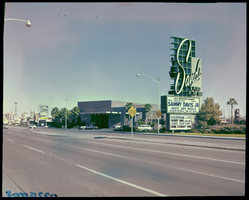
An exterior view of the Sands Hotel and marquee: photographic film
Date
1960 (year approximate) to 1986 (year approximate)
Archival Collection
Description
An exterior view of the Sands Hotel and marquee. The marquee advertises "Jack Entratter presents Will Mastin Trio starring Sammy Davis Jr", "Augie and Margot", "Antonio Morelli and his Music", "Yacoubian & Co.", "Morry King & Violins", "Dave Burton", and the "Erne Stewart Trio". A sign for the Kit Carson Motel is visible in the background. The Sands Hotel and Casino was a historic hotel and casino on the Las Vegas Strip in Nevada, United States, that operated from 1952 to 1996. Designed by the architect Wayne McAllister, with a prominent 56-foot (17 m) high sign, the Sands was the seventh resort to open on the Strip. The hotel was opened on December 15, 1952 as a casino with 200 rooms, and was established less than three months after the opening of another notable landmark, Sahara Hotel and Casino. The hotel rooms were divided into four two-story motel wings, each with fifty rooms, and named after famous race tracks. The last dice in the casino was rolled by Bob Stupak just after 6pm on June 30, 1996. On November 26 of that year, it was finally imploded and demolished. Today, The Venetian Resort Hotel Casino stands where the Sands once stood. The property is located at 3355 Las Vegas Boulevard South, Las Vegas, Nevada 89109.
Image

An exterior view of the Silver Slipper Gambling Hall: photographic film
Date
1960 (year approximate) to 1986 (year approximate)
Archival Collection
Description
An exterior view of the Silver Slipper Gambling Hall. A "Welcome Hunters" sign is visible above the main entrance. The Silver Slipper was a casino in Paradise, Nevada that operated from September 1950 to November 29, 1988. The building was designed by architect Martin Stern, Jr. Opened in 1950, the casino was built on the grounds of the Last Frontier Village[1] of the Hotel Last Frontier, and was originally named the Golden Slipper Saloon and Gambling Hall. The owner originally wanted to call it the Silver Slipper, but there already was an existing establishment with that name. The problem was solved when that small operation was purchased and closed, and the Golden Slipper became the Silver Slipper. The casino was known for its rotating slipper that sat atop the casino. In 2009, the Silver Slipper sign was restored and is now part of a display of vintage signs in the median along Las Vegas Boulevard North.
Image
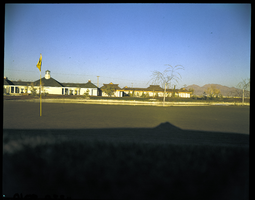
The Tally Ho buildings and golf course: photographic film
Date
1960 (year approximate) to 1986 (year approximate)
Archival Collection
Description
Identified as a view of the Tally Ho buildings and golf course, but it is unclear if this is the correct location. Part of a pond is visible in the background. Frenchman Mountain (commonly referred to as Sunrise Mountain) is visible in the background. For another view see Source ID 0220_0011, Digital ID pho026245. Toy manufacturer Edwin S. Lowe originally opened the 450-room Tally Ho hotel on the property in 1963. The Tally Ho was the only major hotel in Nevada to not include a casino. Milton Prell purchased the hotel in January 1966 and began an extensive $3 million renovation of the property before reopening it as the Aladdin on April 1, 1966. A 19-story hotel tower was added in 1972. After various ownership changes, the Aladdin was closed in 1997 and demolished the following year to make room for a new resort that would also be named Aladdin. The new Aladdin resort opened in August 2000, but suffered financial difficulties and was eventually purchased in 2003 by a partnership of Planet Hollywood and Starwood Hotels & Resorts Worldwide, which renamed it as Planet Hollywood in 2007. The property is located at 3667 South Las Vegas Boulevard, Las Vegas, Nevada 89109.
Image
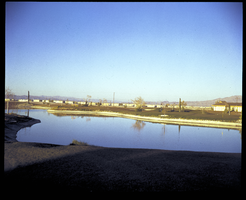
A far view of the Tally Ho buildings and golf course: photographic film
Date
1960 (year approximate) to 1986 (year approximate)
Archival Collection
Description
Identified as a view of the Tally Ho buildings and golf course, but it is unclear if this is the correct location. For another view see Source ID 0220_0010, Digital ID pho026244. Toy manufacturer Edwin S. Lowe originally opened the 450-room Tally Ho hotel on the property in 1963. The Tally Ho was the only major hotel in Nevada to not include a casino. Milton Prell purchased the hotel in January 1966 and began an extensive $3 million renovation of the property before reopening it as the Aladdin on April 1, 1966. A 19-story hotel tower was added in 1972. After various ownership changes, the Aladdin was closed in 1997 and demolished the following year to make room for a new resort that would also be named Aladdin. The new Aladdin resort opened in August 2000, but suffered financial difficulties and was eventually purchased in 2003 by a partnership of Planet Hollywood and Starwood Hotels & Resorts Worldwide, which renamed it as Planet Hollywood in 2007. The property is located at 3667 South Las Vegas Boulevard, Las Vegas, Nevada 89109.
Image
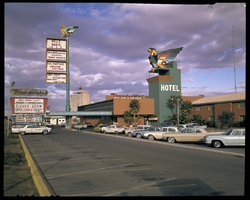
The Thunderbird Hotel and marquee: photographic film
Date
1960 (year approximate) to 1986 (year approximate)
Archival Collection
Description
The Thunderbird Hotel portico and marquees. The marquees are advertising "Belle Barth 12, 3, 5", "Gil & Nikki and the So and So's", "Frank Moore 4", "Val Martinez", "Christine Chatman", "Big Joe's Oyster Bar open daily 11AM to 7AM", "Monty Proser Presents Rodger's and Hammerstein's Flower Drum Song Starring Jack Soo, Januita Hall & Arlene Fontana", "World Famous Buffet Lunch Buffet $1.50, Dinner Buffet $2.50".
Image
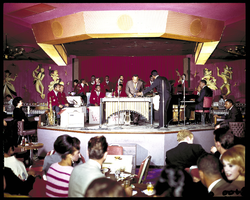
Lionel Hampton performing on the vibraphone: photographic film
Date
1960 (year approximate) to 1986 (year approximate)
Archival Collection
Description
The Lionel Hampton group performing in an unidentified lounge/showroom with several of his band members. Lionel is performing on a vibraphone. Lionel Leo Hampton (April 20, 1908 – August 31, 2002) was an American jazz vibraphonist, pianist, percussionist, bandleader and actor. Hampton worked with jazz musicians from Teddy Wilson, Benny Goodman, and Buddy Rich to Charlie Parker, Charles Mingus, and Quincy Jones. In 1992, he was inducted into the Alabama Jazz Hall of Fame, and was awarded the National Medal of Arts in 1996. The vibraphone (also known as the vibraharp or simply the vibes) consists of tuned metal bars, and is usually played by holding two or four soft mallets and striking the bars. The vibraphone is commonly used in jazz music, in which it often plays a featured role and was a defining element of the sound of mid-20th-century "Tiki lounge" exotica, as popularized by Arthur Lyman.
Image
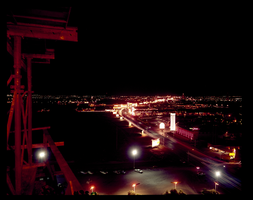
An aerial view of the Las Vegas Strip at night: photographic film
Date
1960 (year approximate) to 1986 (year approximate)
Archival Collection
Description
An aerial view of the Las Vegas Strip at night taken from the Hotel Flamingo looking north. For a southern view see Source ID 0220_0015, Digital ID pho026249.
Image

A nighttime aerial view of the Las Vegas Strip: photographic film
Date
1960 (year approximate) to 1986 (year approximate)
Archival Collection
Description
An aerial of Las Vegas Strip at night looking South. Neon signs for the Sultan's Table (Dunes) restaurant, Denny's restaurant, Hotel Royal palms and Tally Ho are visible. For a northern view see Source ID 0220_0014, Digital ID pho026248.
Image
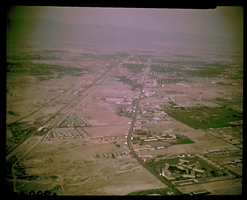
A daytime aerial view of the Las Vegas Strip: photographic film
Date
1960 (year approximate) to 1986 (year approximate)
Archival Collection
Description
A daytime aerial view of the of Las Vegas Strip. The view is from the Hotel Flamingo looking north. For a similar view at night see Source ID 0220_0014, Digital ID pho026248. For a southern view at night see Source ID 0220_0015, Digital ID pho026249.
Image
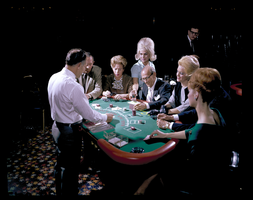
A hand of blackjack in progress: photographic film
Date
1960 (year approximate) to 1986 (year approximate)
Archival Collection
Description
A group of people playing blackjack at an unidentified location. A cocktail waitress is serving drinks to the players. The center player is asking the dealer for a card.
Image
Pagination
Refine my results
Content Type
Creator or Contributor
Subject
Archival Collection
Digital Project
Resource Type
Year
Material Type
Place
Language
